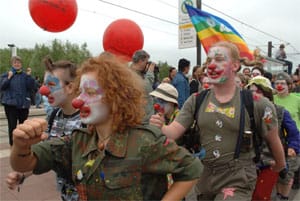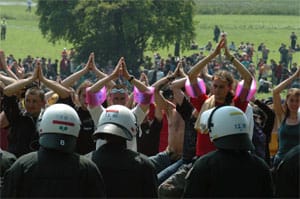The movement against corporate globalization is serious about clowning around.

Clowns aim to force closure of the G8.
"The Clandestine Insurgent Rebel Clown Army" led some of the incursions in the most recent globalization battle, which took place in June at the Group of Eight (G-8) summit meeting in northern Germany.
Like other recent globalization talks, this one was convened in a remote and protected location--an elite private resort on the Baltic Sea. Still, tens of thousands of protesters of all ages, backgrounds, and ethnicities, from soldiers to clowns, were able to block access to the meeting.
Since 1999, when protesters shut down the World Trade Organization meeting in Seattle, international trade summits have become the most popular targets of the global economic justice movement. From Genoa to Canc?n, activists have successfully impeded governments' efforts to enact neoliberal, pro-corporate economic policies at these meetings. Their central goal has been to pierce the security perimeter around the meetings, making it difficult for the delegates and mainstream journalists to get inside the golden fortress.
This tactic creates an image of the masses tearing down the fences to reach the powerful, stopped only by the agents of social control--in this instance, police wielding batons, water cannons, and tear gas against protesters to defend dignitaries and property. It's a compelling image, one that exposes the tension between democracy and capitalism.
The first line of defense of the summit was legal. German courts banned demonstrations around the meeting; police fenced off a 40-square-kilometer demonstration-free zone with razor-wire. The authorities also engaged in advance intimidation. In May, for instance, German security officials raided the offices of dozens of left-wing organizations.

The yoga bloc, 4.75 kilometers inside the 5k exclusion zone.
Police clamped down hard on the diverse array of protests activists staged in the days leading up to the summit. For example, in Rostock, 13,000 police confronted a march and rally of--by their own estimate--about 25,000 demonstrators on June 2. (Organizers put the number at 80,000--either way, an astonishing police:protester ratio.)
Elsewhere, riot police searched people getting off trains and stopped buses headed for the area. A train filled with Polish activists was refused entry into Germany. "Snatch squads"--police who enter a crowd and grab isolated protesters--added to the tensions. In many cases, activists were photographed and interrogated.
These intimidation tactics led some protesters to adopt a defensive stance, but media reports rarely provided this context. As at previous summits, much of the reporting emphasized violence by protesters and downplayed violence by police. While many reporters admitted that only a minority of demonstrators were violent, the media tended to focus on rocks thrown and police injured.
But one of the defining elements of the anti-corporate globalization movement is the creation of democratically controlled institutions, including non-corporate media. Independent Media Centers, or Indymedia, have sprung up all over the world since the first one was created in Seattle for the 1999 WTO protests. Indymedia has become a global movement of its own, decentralized but unified, encouraging anyone with Internet access to post stories and comments and allowing leftist journalists (from novice to highly skilled) to cover events from the bottom up.
Germany's Indymedia featured eyewitness reports of both protests and police violence. Photos, text, audio, and video provided a vivid description of the scene, showing protesters creatively outrunning or outwitting the police, sometimes in unison and sometimes in decentralized groups, to maintain the successful blockade of the roads leading to the summit.
Perhaps more important, the independent media, including Indymedia and other leftist websites, publicized the underlying reasons for the protests. Mainstream media coverage typically terms this movement "anti-globalization," but a quick look at the international solidarity of the protesters gives the lie to that label. While the mainstream media rarely delve beyond the signs and slogans, the alternative media make it clear that the fight is for a globally democratic future.
